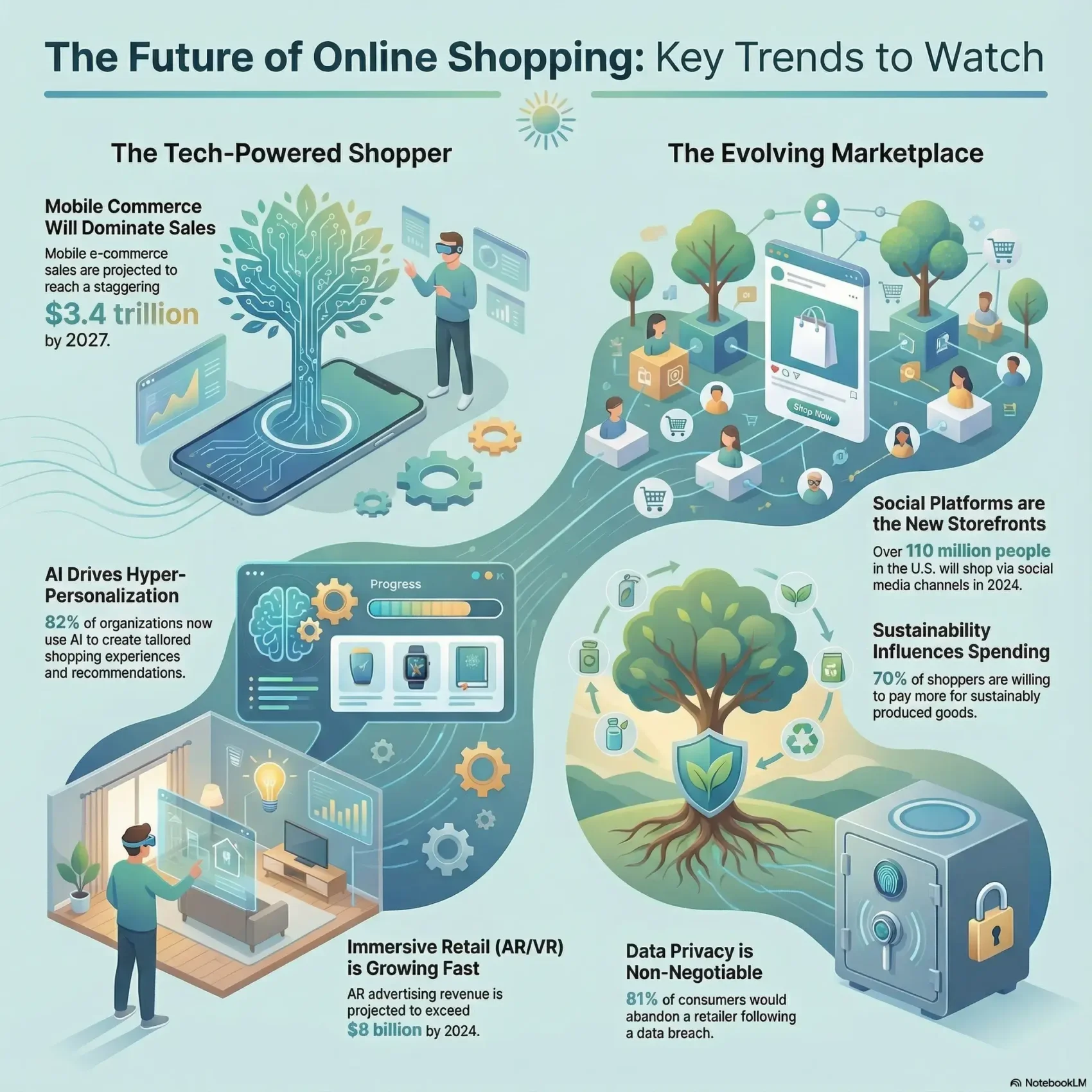Last Updated on December 13, 2025
The digital commerce landscape has seen a remarkable transformation over the past few decades. What began with simple web browsing has evolved into a dynamic market influenced by various factors. Today, navigating the world of online shopping reveals the impact of mobile commerce and advanced technologies like artificial intelligence.
Insights from digital commerce patterns indicate a surge in mobile e-commerce sales, with Statista forecasting a staggering $3.4 trillion by 2027. This rise underscores a shift towards a more mobile-centric shopping experience. Personalization, powered by AI, continues to redefine brand-customer interactions, offering tailored experiences with AI-driven chatbots becoming more prevalent.
The incorporation of augmented reality (AR) and virtual reality (VR) into e-commerce will significantly enhance customer interactions, providing immersive shopping experiences. As consumers increasingly seek sustainable shopping options, businesses must prioritize eco-friendly products and transparent supply chains to meet evolving expectations.
Voice commerce, fueled by technologies like Google Assistant and Alexa, is on the rise. This trend highlights the future of e-commerce leaning towards innovative solutions. Understanding these trends is crucial for both consumers and brands aiming to navigate the competitive marketplace effectively.
Key Insights
- E-commerce is evolving rapidly with mobile commerce sales projected at $3.4 trillion by 2027.
- Personalization through AI is set to enhance customer experiences significantly.
- The integration of AR and VR technologies will provide immersive shopping interactions.
- There’s a rising demand for sustainable and transparent shopping practices.
- Voice commerce is gaining traction as consumers embrace smart voice assistants.
The Rise of Mobile Commerce
Mobile commerce is revolutionizing how we shop, significantly altering consumer behavior and technology. The growth of m-commerce is reshaping your shopping habits, making mobile devices the go-to for online purchases. Statistics show a clear trend towards using smartphones for shopping, highlighting the importance of ease and speed in buying decisions.
Overview of M-commerce Growth
US retail m-commerce sales are projected to hit $558 billion by 2024, underscoring the undeniable growth of mobile commerce. This segment is set to make up about 44.6% of total retail sales. Over 60% of US adults now see mobile shopping as essential to their online activities, signaling a significant shift towards digital buying. With over 6.9 billion smartphones in use worldwide, the need for mobile-friendly shopping platforms is clear.
Impact of Smartphones on Shopping Behavior
The influence of smartphones on shopping habits is broad and deep. Almost 80% of consumers now go straight to retailer websites from their mobile devices while in stores. This trend is especially prevalent among the young, with nearly 70% of Gen Z ready to buy through platforms like TikTok. As you browse social networks, mobile apps offering loyalty programs and special deals become more attractive, enhancing the mobile shopping experience.
As our reliance on mobile devices grows, the average US mobile phone user is set to spend over 3 hours daily on their phones by 2024. These figures highlight the need for retailers to adapt and improve their mobile platforms. Understanding m-commerce trends is crucial for businesses aiming to connect with consumers and tap into the growing mobile commerce market.
Personalization and AI in E-commerce
E-commerce is rapidly embracing personalization, changing how we shop online. The use of AI in e-commerce allows brands to offer shopping experiences tailored to your unique preferences and behaviors. This approach not only increases customer satisfaction but also boosts sales for businesses.
How AI Supports Tailored Shopping Experiences
Artificial intelligence is leading the charge in transforming online shopping. With an astonishing 82% of organizations adopting AI-powered personalization, brands can analyze consumer data to provide tailored recommendations. Research shows that 67% of first-time customers rely on these personalized suggestions when making purchases. Such personalized shopping experiences are crucial, as 78% of customers are more likely to buy again if they see customized content on websites.
The Role of Machine Learning in Customer Engagement
Machine learning boosts customer engagement by adapting to individual shopping patterns. These advanced systems not only recommend products but also facilitate communication through AI-powered chatbots, offering personalized assistance. Companies using AI in their email marketing have seen a significant increase in effectiveness, with 87% utilizing this technology to deliver tailored content. Expect to see more innovations in this area as e-commerce continues to evolve with personalized customer experiences.
E-commerce Trends
Your shopping habits are evolving with the changing e-commerce scene. Today, there’s a notable shift towards sustainability, with consumers demanding eco-friendly practices from retailers. Voice commerce is gaining traction, thanks to the increasing number of smart speakers in homes, offering hands-free shopping. Social media platforms are now integrating shopping features, making it simpler to buy items directly through apps like Instagram. Fast delivery options are crucial, driven by logistics advancements that ensure immediate satisfaction.
Current Trends Driving Changes in Consumer Behavior
Several key trends are influencing online shopping habits. Notable points include:
- The expected 62% of e-commerce sales made through mobile devices by 2027 highlights the need for mobile optimization.
- A projected 110.4 million people will shop via social channels in 2024, underscoring the significance of social commerce.
- With 70% of shoppers willing to pay more for sustainably produced goods, eco-conscious practices are vital for brands.
- Voice search is becoming more popular, affecting how you find and choose products online.
Predictions for the Future of Online Shopping
Looking forward, the future of online shopping is set to be dynamic. Expect to see:
- Artificial intelligence driving personalized marketing efforts, improving your shopping experience with tailored recommendations.
- A robust growth in the subscription economy, projected to reach $1.5 trillion by 2025, catering to your evolving preferences.
- Augmented reality transforming product visualization, making it easier for you to imagine furniture or clothing in your space.
- The continuous push for more diverse payment options, reflecting a growing desire for convenience at checkout.
Virtual and Augmented Reality Technology
Augmented reality (AR) and virtual reality (VR) are revolutionizing online shopping at a rapid pace. These immersive technologies are becoming essential for engaging consumers. Imagine seeing furniture in your living room or trying on clothes virtually before buying; this showcases the immense potential of AR in e-commerce.
Enhancing Consumer Experience with AR and VR
AR in e-commerce creates unique interactions that significantly enhance the consumer experience. Customers can now touch, feel, and experience products in ways traditional online shopping cannot match. This approach has proven successful, with consumers more likely to purchase from brands that use immersive technologies for marketing. By 2020, AR advertising revenue had reached $1.41 billion, and it’s projected to exceed $8 billion by 2024.
Future Integration in E-commerce Platforms
The future of e-commerce platforms is tied to embracing VR technology, leading to more integrated and immersive experiences. Over 83 million individuals in the U.S. engaged with AR in 2020, highlighting the shift’s importance. Retailers are investing heavily, with 20% planning to incorporate AR or VR into their online stores by mid-2020. The advent of 5G technology will further accelerate the adoption of AR and VR in e-commerce, enabling faster and more reliable connections.
Sustainable Shopping Practices
Sustainability is now a key aspect of consumer values, leading to a surge in demand for eco-friendly products. When shopping for clothing, electronics, or home goods, many look for brands that share their commitment to sustainable shopping practices. This shift shows a growing environmental awareness and impacts buying habits on a large scale.
Consumer Demand for Eco-Friendly Products
Over half of consumers now prioritize sustainability, driving them to choose eco-friendly delivery options. They show loyalty to online stores that focus on being eco-friendly. Brands that focus on eco-friendly products are likely to gain more market share and customer trust. Adopting recyclable packaging and cutting carbon emissions are crucial strategies to meet this trend.
The Importance of Transparency in Supply Chains
Transparency in supply chains is crucial for building trust and loyalty among consumers. Brands that openly share their sourcing practices show their dedication to sustainability. Working with partners who also value eco-friendly solutions boosts a company’s reputation and efficiency. Overcoming challenges, like differing sustainability views and communication gaps with partners, is key. Digital technologies like blockchain can enhance visibility and adherence to sustainable practices in the supply chain.
Voice Commerce Expansion
Voice commerce is revolutionizing e-commerce as more consumers turn to voice assistant shopping experiences. The rise of digital assistants like Amazon’s Alexa, Apple’s Siri, and Google Assistant has transformed online shopping. With forecasts suggesting voice assistants will outnumber people globally by 2024, businesses must adapt to these evolving trends to succeed.
The Increasing Use of Voice Assistants in Shopping
Statistics show that 72% of consumers have used voice search through digital assistants. This trend reflects a growing comfort with voice transactions. Moreover, about 25% of consumers have made purchases using these technologies.
Voice commerce seeks to offer a hands-free shopping experience, reducing the need for typing and clicking. This approach enhances interaction with brands, making shopping more natural. For example:
- Users can now complete their shopping journey solely through voice.
- Digital assistants are set to improve, offering personalized recommendations and tracking orders.
- Enhancements in privacy and security will be crucial to protect customer data in voice-activated settings.
Voice shopping is transforming the e-commerce landscape by altering how we interact with online retailers. Brands can now deliver targeted offerings, significantly boosting customer satisfaction. By embracing voice commerce trends, businesses can remain competitive and offer innovative shopping experiences.
Social Commerce Growth
Social commerce is revolutionizing online shopping. Platforms like Instagram, TikTok, and Facebook are transforming into major e-commerce hubs. As you explore these platforms, you’ll notice how shopping features blend seamlessly with social interactions, making your online shopping experiences both interactive and engaging.
How Social Media Platforms Are Evolving
The rise of social media has profoundly changed how we shop. In 2024, US adults will spend 11.4% of their daily media time and 17.9% of their digital time on social platforms. Over half of US shoppers aged 18 to 29 plan to use TikTok for holiday shopping, showing social media’s growing influence on buying decisions. Brands now focus on creating visually appealing content to encourage product discovery and engagement.
By 2024, there will be 110.4 million US social buyers, over 50% of all social media users. This statistic underscores the importance of social commerce in today’s market.
Leveraging Influencer Marketing for Sales
Influencer marketing has become a key player in e-commerce, reshaping sales strategies. By partnering with influencers, brands can boost visibility, build trust, and increase sales. A third of Gen Z consumers have bought from influencer-backed brands in the past year, proving the power of these endorsements.
This trend shows the potential of influencer marketing for brands aiming to succeed in the digital landscape. Despite challenges in measuring ROI, continuous learning and experimentation are crucial for success in this evolving field.
Advancements in Supply Chain and Logistics
The significance of logistics advancements in e-commerce is undeniable as the industry expands. You’ve likely observed how efficient supply chain strategies are crucial for an online business’s success. Companies are now investing in technology and innovative solutions to streamline operations, cut costs, and improve customer experiences.
Importance of Efficient Logistics in E-commerce
Efficient logistics is crucial for the smooth operation of e-commerce platforms. Fast shipping is a top priority as consumers expect quick delivery. Recent statistics reveal that 87% of businesses faced supply chain disruptions, leading to delays for customers. In response, many companies are enhancing their logistics processes through automation and real-time monitoring to manage inventory levels and demand shifts effectively. This approach can lead to order accuracy rates of 95%-98%, ensuring timely and correct delivery to customers.
Innovations Such as Drone Deliveries
Drone delivery innovations are transforming logistics. These technologies tackle last-mile logistics challenges, especially in urban settings. By 2035, it’s estimated that 45% of supply chains could be largely autonomous. This shift is driven by the need for quicker and more affordable delivery solutions. Drones have the potential to cut last-mile costs, which account for 40% to 55% of total shipping expenses. This could help e-commerce companies meet growing consumer expectations while keeping costs under control.
Data Privacy and Security Concerns
In the fast-evolving world of e-commerce, you face growing security concerns in online shopping. The retail landscape is changing rapidly, with a strong focus on data privacy in e-commerce. Companies must now protect consumer data more than ever, given that 81% of consumers would leave an online retailer after a data breach.
The Impact of Data Breaches on Consumer Trust
Data breaches can severely damage consumer trust and a brand’s reputation. About 71% of consumers won’t buy from a company they don’t trust. This shows how crucial secure data handling is to consumer behavior. With new laws in the U.S. since 2023, your business must comply and prioritize data integrity.
Companies are now valuing first-party and zero-party data more, moving away from third-party sources due to consent issues. This shift is expected to lead to 85% of businesses adopting personalization strategies soon. This change reflects growing consumer expectations for personalized shopping experiences.
To address consumer trust issues, being transparent about data handling is key. Laws like the GDPR and CCPA let consumers access and review their data across different platforms. This transparency puts the onus on retailers to handle these legal complexities well.
With 75% of consumers ready to switch retailers over security concerns, building trust is crucial. Offering strong security measures not only builds loyalty but also encourages more personal data sharing.
Given that 97% of consumers worry about data misuse, e-commerce operators must uphold high data privacy and security standards. Staying ahead in this competitive landscape is vital, as consumer trust directly impacts your success.
Emerging Retail Trends for 2024
Looking ahead to 2024, the e-commerce landscape is undergoing significant changes. Retailers must adapt to new retail trends and tackle global market challenges. These challenges impact their operations and how they engage with consumers.
Global Market Expansion and Its Challenges
The global market’s expansion offers exciting opportunities for e-commerce businesses. Emerging economies are becoming crucial, opening doors for international sellers to reach new customers. Your strategy must evolve to accommodate local regulations and cultural tastes. The push for sustainable practices is growing, with consumers choosing eco-friendly options that align with their values.
For 2024, e-commerce predictions highlight a strong focus on technology. Retailers are embracing tools like augmented reality to create immersive shopping experiences. Companies like Ikea are leading the way, using AR to boost customer engagement and sales.
Despite these opportunities, global market challenges persist. With heightened competition, having a strong data collection strategy is vital. Understanding customer behavior through data analytics and AI is crucial. Personalization will be a key factor, allowing businesses to offer products that match individual shopping habits.
- Enhanced security measures are essential as consumers demand more privacy in their online interactions.
- Sustainable shipping practices will help attract eco-conscious buyers.
- Implementing blockchain technology can improve supply chain transparency, fostering trust with clients.
Conclusion
The e-commerce landscape is constantly evolving, shaped by changing consumer preferences and technological innovation. The recent surge in global ecommerce sales, exceeding $1.14 trillion, underscores its dynamic and competitive nature. This overview of e-commerce trends points out crucial areas like mobile commerce, AI-driven personalization, and sustainability. These elements are reshaping the online shopping experience.
The growth of social commerce and augmented reality is revolutionizing online shopping. With AR devices set to hit 1.7 billion by 2024, over half of consumers are already using AR to enhance their shopping. This trend shows how crucial it is to adapt to these changes to meet consumer demands in the evolving online shopping landscape.
As we face new challenges, such as the need for better data security and transparency, retailers must stay informed and adaptable. Adopting innovative solutions and prioritizing customer satisfaction, aided by AI customer service tools, can help businesses thrive.








